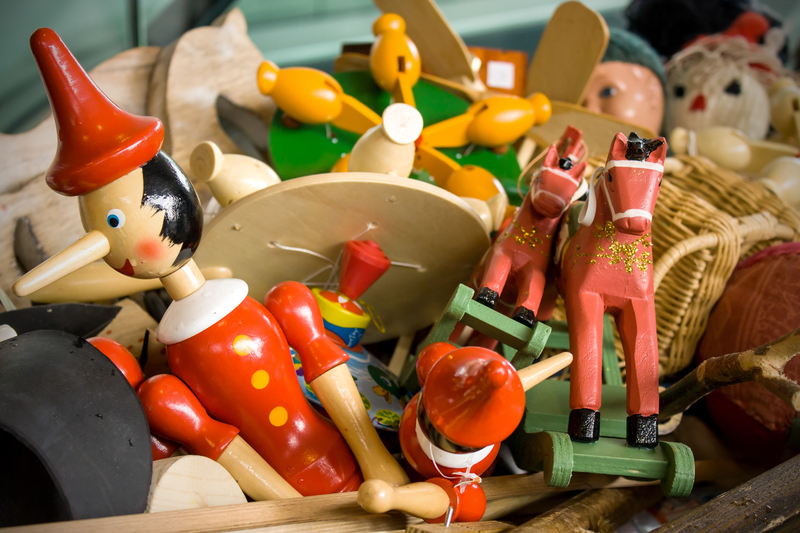Giving Worn Out Clothes a Bold Second Act Through Upcycling
In today's fast-paced world of fashion, many of us find ourselves staring at piles of worn out clothes, unsure whether to throw them away or let them languish at the back of our closets. With concerns over textile waste and sustainability on the rise, upcycling clothes has emerged as a powerful and creative solution. Giving old garments a bold second act through upcycling doesn't just help the environment--it also allows us to unleash our creativity and build unique, one-of-a-kind pieces that reflect our personal style.

Why Upcycling Worn Out Clothes Matters
Textile waste is a massive global problem. According to the Environmental Protection Agency, millions of tons of clothing end up in landfills each year. Not only does this contribute to environmental pollution, but the production of new garments often results in significant use of water, energy, and toxic chemicals. By embracing upcycling--or creatively reusing discarded textiles--you're not just keeping your favorite worn out items in circulation; you're also joining a powerful movement toward sustainable fashion and environmental stewardship.
The Environmental Impact of Fashion Waste
- Landfill Overflow: Every year, billions of pounds of clothes are thrown away, overwhelming landfills worldwide.
- Resource Consumption: The fashion industry uses enormous amounts of water, fuel, and chemicals, which could be reduced by minimizing demand for new garments.
- Greenhouse Gas Emissions: Decomposing textiles in landfills release methane, a potent greenhouse gas.
Upcycling helps reduce these impacts by diverting textiles from landfills and cutting down the need for new materials. What's more, it's a fantastic way of breathing new life into garments you already own.
What is Upcycling, and How Does It Differ from Recycling?
It's common to conflate upcycling with recycling, but these two processes are quite different:
- Recycling involves breaking down materials back into their raw elements to create new products. This often requires energy-intensive processes and sometimes results in lower-quality materials.
- Upcycling involves reusing textiles in their current form (or with minimal alteration) and transforming them into items of higher value or extended usefulness. This might mean turning an old shirt into a tote bag, or giving a ripped pair of jeans a decorative upgrade.
The core idea behind upcycling worn out clothes is to add value, creativity, and personality, rather than simply extending their lifespan through patching or mending.
Getting Started: Assessing Your Wardrobe for Upcycling Potential
If you're ready to give your worn clothes a bold second act, start with a thorough wardrobe assessment. Here's how:
- Sort by Condition: Make separate piles for truly unwearable items (with holes, stains, irreparable damage) and those that just need a new look.
- Consider Fabric Types: Denim, cotton, linen, and wool are ideal for upcycling. Slippery synthetics can be more challenging but not impossible.
- Identify Sentimental Pieces: Clothes with emotional value deserve special upcycling projects to retain their personal significance.
- Look for Inspiration: Think about what you need. Do you want new tote bags, a quilt, or bold statement patches for your jacket?
By taking inventory of your garment collection, you'll be prepared to make smart, sustainable, and creative choices about which pieces are ripe for upcycling.
Creative Upcycling Ideas for Worn Out Clothes
Customizing Denim: Turn Old Jeans into Fashion Statements
- Patching and Embroidery: Cover holes with colorful patches or simple embroidery for a stylish, personalized touch.
- Upcycled Denim Bags: Repurpose the sturdy material into handbags, backpacks, or even practical storage bins for home use.
- Distressed Denim Shorts: Cut worn jeans into shorts and finish the edges with lace, fringe, or bold contrasting fabric for summery new looks.
Transforming T-Shirts: From Closet Castoffs to Coveted Creations
- Tote Bags: Turn graphic tees and old cotton shirts into reusable shopping bags in a few simple steps--no sewing required!
- Quilts and Throws: Patchwork together t-shirt squares to make cozy blankets that double as memory keepers.
- Knotted Rugs: Cut t-shirts into strips and braid them into colorful, durable floor rugs.
Giving Sweaters and Cardigans a New Purpose
- Upcycled Pillows: Use the softest parts of sweaters to make plush throw pillows. Even sleeves can be reused as nifty bottle warmers for gifts.
- Fingerless Gloves: Cut and finish sweater sleeves for unique, handmade gloves.
- Pillowcase or Soft Toys: Knitwear is perfect for making soft toys or pet beds.
Revamping Shirts and Blouses
- Aprons and Kitchen Accessories: Button-down shirts make excellent kitchen aprons or napkin sets.
- Accessorize: Collars, cuffs, and pockets can be removed and transformed into statement necklaces, brooches, or hair accessories.
Don't forget: Fabric scraps that seem too small can be used for patchwork, cleaning cloths, or stuffing for other projects!
Upcycling Techniques and Tips for Success
Basic Techniques Every Beginner Should Know
- Sewing and Mending: With simple stitches, you can reinforce edges, patch holes, or attach embellishments.
- Fabric Painting and Dyeing: Use non-toxic fabric paints or dyes to refresh faded colors or add bold, artsy designs.
- No-Sew Methods: Techniques like knotting, braiding, and gluing are perfect for those without sewing skills or tools.
Top Tips for Successful Clothing Upcycling
- Start Small: Begin with a basic project--like turning a t-shirt into a tote--before progressing to complex garment renovations.
- Plan Ahead: Sketch your ideas or search for inspiration online before cutting into your fabric.
- Use the Right Tools: Sharp scissors, fabric glue, sewing needles, and a good iron are essential.
- Embrace Imperfection: The joy of upcycling comes from unique, handmade results. Don't worry about perfection. Instead, celebrate character and originality.
Inspiring Success Stories: Worn Out Clothes with a Second Life
Countless designers, artists, and everyday people are already transforming their worn out clothes into extraordinary new treasures. In cities around the world, upcycled fashion brands are creating headlines by showcasing stunning collections built entirely from discarded apparel. Social media is overflowing with before-and-after stories of upcycled garments, inspiring audiences to look at their old clothes in a new light.
- Stella McCartney and Eileen Fisher: Leading designers known for incorporating upcycled materials in their collections.
- Zero Waste Daniel: Fashion designer who transforms fabric scraps and secondhand clothes into colorful, wearable art.
- Local Crafters: Enthusiasts sharing tutorials and ideas on platforms like YouTube, Instagram, and TikTok, motivating others to try their hand at creative upcycling.
Community Impact: Clothing Swaps & Upcycling Workshops
Many cities and organizations are hosting clothing exchanges and upcycling workshops, where people can learn new skills, share ideas, and trade old garments for new (handmade) treasures. Events like these foster creativity and help build a local culture of sustainable style.
How to Share Your Upcycled Creations with the World
Documenting and sharing your upcycling journey not only celebrates your achievements but encourages others to join the movement. Consider:
- Social Media Posts: Share before-and-after photos on Instagram or Pinterest with hashtags like #UpcycledFashion or #SecondLifeClothing.
- Blog Tutorials: Write step-by-step guides to help others replicate your projects.
- Pop-Up Shops and Craft Fairs: Sell or display your upcycled creations at local events to inspire your community.
Whether you're a seasoned crafter or a newcomer, sharing stories of renewed garments helps sustain the upcycling movement and encourages others to see the value in what might otherwise be overlooked as waste.
The Economic Benefits of Upcycling Your Worn Clothes
Upcycling isn't just good for the planet and your wardrobe--it also makes financial sense. Here's how:
- Save Money: Instead of buying new items, you replenish your wardrobe using what you already own. Creative upcycling can stretch household budgets and reduce your reliance on fast fashion.
- Earn Extra Cash: Unique, hand-crafted upcycled pieces are increasingly desirable at craft fairs, vintage markets, and online stores like Etsy. Your upcycling skills could become a source of side income or even a new business.
- Decrease Waste Collection Fees: Reducing your family or business's clothing waste can mean lower trash collection and disposal fees, especially for organizations.

Frequently Asked Questions About Upcycling Worn Out Clothes
What clothing items are best for upcycling?
Natural fibers--such as cotton, linen, denim, and wool--are most versatile. However, with a little creativity, even synthetic garments can be beautifully upcycled. The only restriction is your imagination!
Do I need to know how to sew?
While sewing skills are useful for advanced projects, many upcycled clothing projects require only basic hand sewing, gluing, or even clever knotting. There are plenty of beginner-friendly, no-sew upcycling ideas to try.
How do I make sure upcycled clothes are comfortable and durable?
Always use quality supplies and reinforce seams where needed. Wash fabric before starting projects, and try to use soft, well-worn garments for items that will sit against the skin.
Is upcycled clothing fashionable?
Absolutely! Many of the world's top designers and trendsetters are embracing upcycled apparel. The unique stories and bold designs behind upcycled pieces make them more desirable as statement items.
Conclusion: Embrace a Bolder, Greener Wardrobe with Upcycling
From patching denim to weaving t-shirt rugs or reinventing a faded dress as a stylish tote, giving worn out clothes a bold second act through upcycling represents an inventive, eco-friendly approach to fashion. Each upcycled creation not only diverts waste from landfills, but also makes a unique contribution to your personal style and environmental impact.
Now is the perfect moment to look at your wardrobe with fresh, creative eyes. Transform what's old into something dazzlingly new, and join a growing global movement that fuses sustainability, economy, and artistry. Dare to redefine fashion, one upcycled project at a time!
Looking for more inspiration? Explore DIY upcycling communities online, attend local workshops, and check out social media hashtags like #UpcycledFashion and #ZeroWasteStyle to connect with like-minded creators.
Your worn clothes aren't just leftovers--they're the raw material for your next masterpiece!